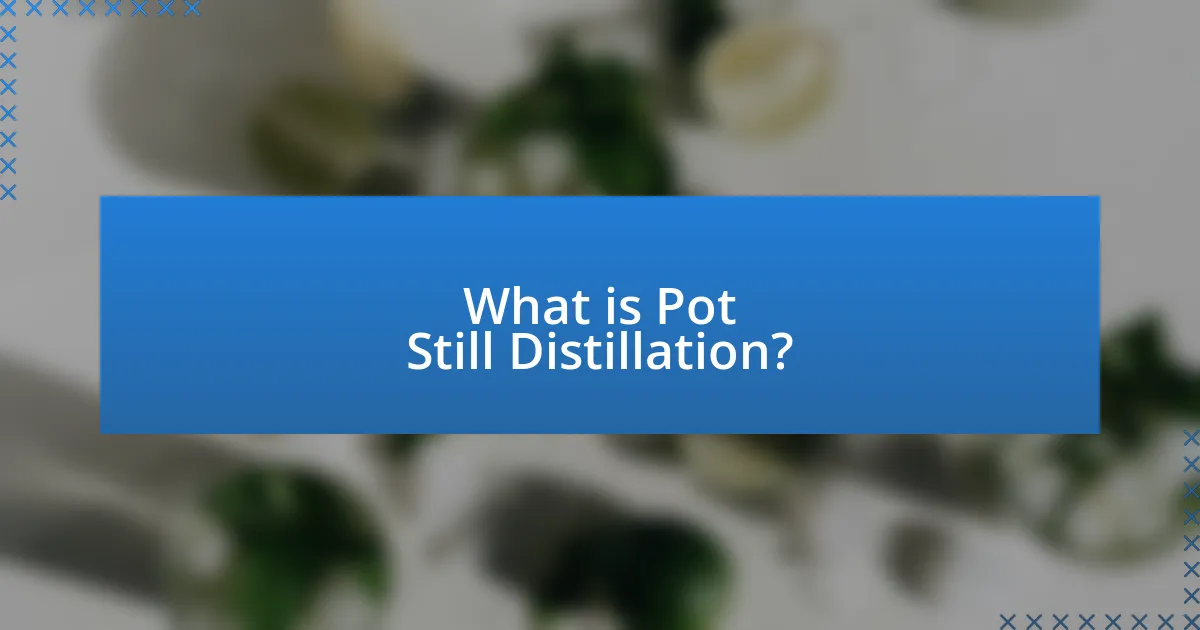Pot still distillation is a traditional method used to produce alcoholic beverages, characterized by the use of a pot still apparatus made typically of copper. This article provides a comprehensive overview of pot still distillation, detailing its historical origins, key characteristics, and the step-by-step process involved. It highlights the differences between pot still and other distillation methods, the cultural significance of pot still distillation in regions like Ireland and Scotland, and best practices for achieving high-quality spirits. Additionally, the article addresses common challenges faced during the distillation process and offers tips for beginners to enhance their distillation skills.

What is Pot Still Distillation?
Pot still distillation is a traditional method of distilling alcoholic beverages using a pot still, which is a type of distillation apparatus. This process involves heating a fermented mash in a pot, allowing the alcohol to vaporize and then condense back into liquid form in a separate chamber. Pot stills are typically made of copper, which helps to remove impurities and enhance the flavor profile of the distilled spirit. This method is commonly used for producing whiskey, rum, and certain types of brandy, and it is known for creating spirits with a rich and complex character due to the single distillation process, which retains more of the original flavors from the mash compared to column still distillation.
How does Pot Still Distillation differ from other distillation methods?
Pot Still Distillation differs from other distillation methods primarily in its design and operation, utilizing a single distillation process that allows for a more flavorful and aromatic spirit. Unlike column stills, which operate continuously and can achieve higher alcohol concentrations through multiple distillations, pot stills typically produce spirits with a lower alcohol content and a richer character due to the retention of more congeners and impurities. This method is traditionally used for producing whiskey and rum, where the complexity of flavor is highly valued, as evidenced by the production practices in regions like Scotland and Ireland, where pot stills are a hallmark of their distillation heritage.
What are the key characteristics of Pot Still Distillation?
Pot Still Distillation is characterized by its use of a traditional pot still, which allows for the production of spirits with rich flavors and aromas. This method involves a single distillation process, where the wash is heated in a pot, and the vapors are collected and condensed. The pot still’s design, typically made of copper, facilitates the removal of impurities and enhances the spirit’s character. Additionally, pot still distillation often results in a higher alcohol by volume (ABV) compared to column stills, as it retains more of the original flavors from the fermented wash. This technique is commonly used in the production of whiskey and rum, where the emphasis is on flavor complexity rather than high purity.
Why is Pot Still Distillation preferred for certain spirits?
Pot Still Distillation is preferred for certain spirits because it allows for greater flavor retention and complexity. This method involves a single distillation process that preserves the original characteristics of the raw materials, such as grains or fruits, resulting in a richer and more aromatic spirit. For example, traditional whiskies and rums often utilize pot stills to enhance their unique flavor profiles, as evidenced by the production methods of renowned distilleries like those in Scotland and the Caribbean. The design of pot stills, which includes a wide body and a narrow neck, facilitates the separation of volatile compounds, further contributing to the depth of flavor in the final product.
What are the historical origins of Pot Still Distillation?
Pot still distillation originated in ancient Mesopotamia around 2000 BCE, where early forms of distillation were used for producing perfumes and medicinal substances. The technique evolved through the centuries, with significant advancements made by the Arabs in the 8th century, who refined the process and created more efficient stills. By the 12th century, pot stills were utilized in Europe, particularly in Ireland and Scotland, for the production of whiskey and other spirits. Historical records indicate that the pot still became the preferred method for distilling malt whiskey due to its ability to produce rich flavors and aromas, solidifying its importance in the craft of distillation.
How has Pot Still Distillation evolved over time?
Pot Still Distillation has evolved significantly from its origins in ancient civilizations to modern practices. Initially, pot stills were simple, rudimentary devices used for distilling alcohol, primarily in the Middle East around 2000 BC, where they were made from clay or metal. Over time, advancements in metallurgy and engineering led to the development of more efficient copper pot stills in the 18th century, which improved the quality and purity of distilled spirits.
The introduction of the continuous column still in the 19th century marked a pivotal shift, allowing for higher alcohol yields and greater efficiency, although pot stills remained popular for producing high-quality spirits like Scotch whisky and Irish whiskey. Today, pot still distillation is celebrated for its ability to create rich, complex flavors, with many distilleries employing traditional methods alongside modern technology to enhance the distillation process while preserving the heritage of the craft.
What cultural significance does Pot Still Distillation hold?
Pot Still Distillation holds significant cultural importance, particularly in regions like Ireland and Scotland, where it is deeply intertwined with local traditions and heritage. This method of distillation is often associated with the production of whiskey, which has historical roots dating back centuries, contributing to national identity and pride. For example, the use of pot stills is a traditional practice that distinguishes Irish whiskey from other spirits, emphasizing craftsmanship and authenticity. The cultural significance is further highlighted by the role of pot still distillation in community gatherings and celebrations, where locally produced spirits are enjoyed, fostering social bonds and cultural continuity.
What are the main components of a Pot Still?
The main components of a pot still are the boiler, the condenser, and the neck. The boiler is where the mash or wash is heated to produce vapor. The condenser cools the vapor back into liquid form, allowing for the collection of distillate. The neck connects the boiler to the condenser and plays a crucial role in directing the vapor flow. Each component is essential for the distillation process, ensuring efficient separation of alcohol from the wash.
What materials are typically used in constructing a Pot Still?
Pot stills are typically constructed using copper and stainless steel. Copper is favored for its excellent thermal conductivity and ability to remove sulfur compounds, which enhances the quality of the distilled spirit. Stainless steel, on the other hand, is durable, resistant to corrosion, and easier to maintain, making it a popular choice for modern pot stills. The combination of these materials allows for efficient distillation while ensuring the longevity and effectiveness of the still.
How do the design features of a Pot Still influence the distillation process?
The design features of a Pot Still significantly influence the distillation process by determining the efficiency of vaporization and the separation of alcohol from impurities. The shape of the pot, typically bulbous, allows for a larger surface area for heat transfer, which enhances the vaporization of the liquid. Additionally, the height and angle of the neck affect the reflux ratio; a taller neck can lead to more reflux, allowing for better separation of volatile compounds. The material of the still, often copper, plays a crucial role in removing sulfur compounds, which can improve the flavor profile of the distilled spirit. These design elements collectively impact the purity and character of the final product, as evidenced by the traditional use of Pot Stills in producing high-quality spirits like Scotch whisky and Irish whiskey.
What is the step-by-step process of Pot Still Distillation?
The step-by-step process of pot still distillation involves several key stages:
- Fermentation: Yeast converts sugars in the mash into alcohol, producing a liquid called “wash” with an alcohol content of around 5-10%.
- Heating: The wash is transferred to the pot still, where it is heated. The alcohol evaporates at a lower temperature than water, allowing it to separate.
- Condensation: The vapor rises through the neck of the still and enters the condenser, where it cools and turns back into liquid form.
- Collection: The distilled liquid, known as “distillate,” is collected in a separate container. The first portion, called “heads,” contains undesirable compounds and is usually discarded.
- Heart and Tails: The next portion, known as the “heart,” is the desired product, while the “tails” contain heavier compounds and are often collected for further distillation or discarded.
- Aging (optional): The heart can be aged in barrels to develop flavor, though this step is not part of the distillation process itself.
This process is widely used in the production of spirits like whiskey and rum, emphasizing the importance of each step in achieving the desired flavor and alcohol content.
What preparations are necessary before starting the distillation process?
Before starting the distillation process, it is essential to gather all necessary equipment and ingredients. This includes a pot still, heat source, fermentation vessel, and the liquid to be distilled, typically a fermented mash or wash. Additionally, ensuring that the workspace is clean and safe is crucial, as well as checking that all equipment is properly assembled and functioning. Proper preparation minimizes risks and enhances the efficiency of the distillation process, as confirmed by industry best practices which emphasize the importance of readiness in achieving optimal results.
How is the mash prepared for distillation?
The mash is prepared for distillation by first mixing crushed grains with hot water to create a mash. This process activates enzymes in the grains, which convert starches into fermentable sugars. The mixture is then maintained at specific temperatures to optimize enzyme activity, typically around 150°F to 160°F (65°C to 71°C). After sufficient time, usually one to two hours, the mash is cooled and transferred to a fermentation vessel, where yeast is added to initiate fermentation. This method is supported by the fact that proper temperature control and enzyme activation are crucial for maximizing sugar extraction, which is essential for producing alcohol during distillation.
What are the key steps during the actual distillation process?
The key steps during the actual distillation process include heating the liquid mixture, vaporization, condensation, and collection. First, the liquid mixture is heated in a pot still, causing the components with lower boiling points to vaporize. As the vapor rises, it enters a condenser where it cools and condenses back into liquid form. Finally, the condensed liquid, known as distillate, is collected in a separate container. This process effectively separates the desired components based on their boiling points, ensuring a higher concentration of the target substance in the distillate.
How is the distillate collected and what are the considerations for quality?
Distillate is collected through a process involving condensation of vapor in a pot still, where the vapor rises through the neck and enters a condenser, transforming back into liquid. Key considerations for quality include the temperature control during distillation, which affects the separation of desirable compounds from undesirable ones, and the selection of the appropriate collection cut, ensuring that only the heart fraction, which contains the best flavor and aroma compounds, is retained while heads and tails are discarded. Maintaining a consistent distillation rate and monitoring the distillate’s clarity and aroma further ensures high-quality output.
What are the common challenges faced in Pot Still Distillation?
Common challenges faced in pot still distillation include maintaining consistent temperature control, managing fermentation quality, and achieving desired separation of alcohol and impurities. Temperature fluctuations can lead to variations in distillation efficiency, affecting the final product’s flavor and quality. Additionally, poor fermentation can result in undesirable compounds that carry over during distillation, impacting the spirit’s taste. Lastly, achieving the right balance in the distillation process is crucial, as improper separation can lead to higher levels of congeners, which may negatively affect the spirit’s overall profile.
How can temperature control affect the distillation outcome?
Temperature control significantly affects the distillation outcome by influencing the volatility of components in the mixture. Precise temperature regulation allows for the separation of different compounds based on their boiling points, ensuring that desired fractions are collected while minimizing impurities. For instance, maintaining a lower temperature during the initial stages of distillation can help capture lighter, more volatile compounds, while gradually increasing the temperature allows for the extraction of heavier components. This method enhances the purity and quality of the final distillate, as evidenced by studies showing that optimal temperature profiles can lead to higher yields of specific alcohols while reducing unwanted byproducts.
What are the signs of a poorly executed distillation?
Signs of a poorly executed distillation include the presence of off-flavors, inconsistent alcohol content, and cloudy distillate. Off-flavors often arise from the inclusion of unwanted compounds, such as fusel oils, which can occur if the distillation process is not carefully controlled. Inconsistent alcohol content indicates improper separation of the distillate fractions, leading to a mix of heads, hearts, and tails rather than a clean product. Cloudy distillate typically results from emulsions or impurities that were not adequately removed during the distillation process. These signs collectively indicate that the distillation did not achieve the desired purity and quality standards.
What are the best practices for successful Pot Still Distillation?
The best practices for successful pot still distillation include maintaining optimal fermentation conditions, ensuring proper temperature control during distillation, and conducting multiple distillation runs for purity. Optimal fermentation conditions, such as using high-quality yeast and maintaining appropriate temperature and pH levels, enhance the production of desirable alcohols. Proper temperature control during distillation prevents the loss of volatile compounds and ensures that the distillate is collected at the right points, maximizing flavor and aroma. Conducting multiple distillation runs, typically a first distillation followed by a second, allows for the separation of heads, hearts, and tails, resulting in a cleaner and more refined spirit. These practices are supported by industry standards and historical techniques that have proven effective in producing high-quality spirits.
How can one ensure the quality of the final product?
To ensure the quality of the final product in pot still distillation, one must implement rigorous quality control measures throughout the distillation process. This includes selecting high-quality raw materials, maintaining precise temperature control during distillation, and conducting regular sensory evaluations of the distillate. Research indicates that maintaining a consistent distillation temperature can significantly affect the flavor profile and purity of the final product, as variations can lead to undesirable compounds being present. Additionally, employing proper cleaning and maintenance of the still equipment prevents contamination, further enhancing product quality.
What tips can help beginners avoid common mistakes?
Beginners can avoid common mistakes in pot still distillation by thoroughly researching the distillation process and understanding the equipment involved. Familiarizing oneself with the specific functions of each component, such as the pot still, condenser, and thermometer, is crucial for effective operation. Additionally, maintaining precise temperature control is essential, as fluctuations can lead to undesirable flavors in the final product.
Moreover, beginners should practice proper sanitation techniques to prevent contamination, which can spoil the distillate. Following a detailed recipe and measuring ingredients accurately helps ensure consistency and quality. Lastly, keeping a detailed log of each distillation session allows beginners to track their progress and identify areas for improvement, ultimately enhancing their skills over time.


